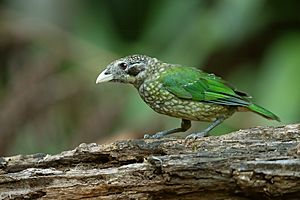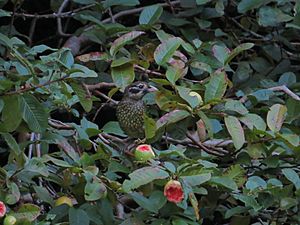Spotted catbird facts for kids
Quick facts for kids Spotted catbird |
|
|---|---|
 |
|
| Scientific classification | |
| Genus: |
Ailuroedus
|
| Species: |
maculosus
|
The spotted catbird (Ailuroedus maculosus) is a fascinating bird. It belongs to the bowerbird family, but it's a bit different. Unlike most bowerbirds, it does not build a special "bower" to attract a mate. You can find these birds in northern Queensland, Australia, as well as in the eastern Moluccas and New Guinea.
This bird is quite common across its wide home range. Because of this, the IUCN Red List of Threatened Species lists the spotted catbird as "Least Concern." This means it's not currently at risk of disappearing.
Contents
About the Spotted Catbird
The spotted catbird is one of ten species in the Ailuroedus group. These are the bowerbirds that don't build bowers. A key difference between the two Australian catbird species is that the spotted catbird has less black around its ears and fewer spots on its back.
Scientists believe that the Ailuroedus group is a unique branch of the bowerbird family. They are the only bowerbirds in Australia that stay with one partner (monogamous). Other bowerbirds often have many partners (polygynous) and build fancy bowers or clear special areas for mating.
Where Spotted Catbirds Live
Spotted catbirds are found in the Australo-Papuan region. They live in tropical rainforests and are common in these areas. In Australia, they have two separate groups. One lives on Cape York, and the other is further south in the wet tropics of Queensland.
The forests around the Bellenden Ker mountain range are like a main home for these birds. Spotted catbirds are very picky about their homes. They prefer well-vegetated areas with steep creek slopes. They also like forests with thick tangles of plants called Calamus. They often build their nests in the same spot year after year. Each pair usually has a home range of about 1 to 2 hectares. They typically look for food about 68 meters away from their nests.
Threats to Their Home
The homes of spotted catbirds face some challenges. Losing their rainforest habitat is a big threat. Rising temperatures could also harm them. People have tried to replant forests in some areas, like the Atherton Tablelands. However, these new areas might not be perfect for these specific rainforest birds.
Sometimes, these efforts create small "corridors" of forest. While these are meant to help birds, they can be affected by "edge effects." This means the edges of the forest are different from the deep inside. Specialized rainforest birds often don't use these corridors. Still, spotted catbirds have been seen in well-grown rainforest areas that have been replanted.
What They Look Like
Spotted catbirds are about 26 to 30 centimeters long. Males weigh around 180 grams, and females are a bit lighter at 168 grams. Adult birds have a large, dark head with a blackish cap and a black patch near their ears.
Their upper bodies are mostly bright green. They have strong olive-colored V-shapes and white streaks on their undersides. Their wings have thin white bars, and their green tails have white tips. They have red eyes and a strong, cream-colored beak. Their legs and feet are dark to bluish-grey. Both male and female catbirds look very similar.
Their colors help them blend into their surroundings. This "cryptic plumage" helps parents take care of their young. It allows both males and females to stay hidden while tending to the nest. It also helps them spend more time looking for food, as they are hard to spot in the leaves.
Their voice is very unique. It's described as loud and sounds like a cat wailing! They also make a nasal "here-I-arr" call with sharp clicks and three loud cries. You can hear them calling throughout the day, especially at dawn and dusk. They call more often when it's cooler, dewy in the mornings, or after it rains.
Behavior
Spotted catbirds are known for being curious. Imagine walking into a forest and hearing a catbird call from a distance. It might call several times, each time getting closer. Soon, you might see the bird on a branch nearby, still calling. It will watch you closely. After a short time, its mate might even arrive, answering the calls of the first bird. They also show behaviors similar to other perching birds, like hopping around in trees.
What They Eat
The spotted catbird mainly eats fruit. This means they are frugivorous. They look for food at different heights, often on the ground. They use their strong feet and powerful beaks to eat small fruits, usually less than 10mm wide. They also eat larger fruits, between 13-21mm wide, that don't have hard shells.
Their bright green feathers might stop them from joining groups of brown and black birds that forage together in the rainforest. One person observed that spotted catbirds become very bold during cumquat season. They were seen eating mandarins alongside honeyeaters. They enjoy seeds from palms, wild figs, berries from stinging trees, and all kinds of soft fruits.
Spotted catbirds also eat beetles and other insects. They will even eat new buds and shoots from ferns. Adults and their young have been seen eating cicadas. Parents feed cicadas to their nestlings. Spotted catbirds have also been observed eating eggs from other bird nests. They have even been seen feeding young birds from other nests to their own chicks. It's also thought that catbirds eat small, soft-shelled snails.
Reproduction and Life Cycle
The Ailuroedus group of bowerbirds, including the spotted catbird, forms pairs that stay together. They do not build bowers. Both the male and female defend their territory. Spotted catbirds form strong pair bonds, and some pairs stay together for more than one breeding season. Scientists believe this monogamy is important because it takes two parents to successfully raise their young.
Mating Behavior
During courtship, the male and female excitedly hop around on tree branches. The male makes sharp "tic" sounds until the female sits still. Then, the male hops around the female between two branches, often holding food in his beak.
One observation of catbirds mating in captivity described the male holding food in his beak. He would get close to the female and stretch his head and neck straight up. He would look at her, and the feathers on his neck would stand up a little. He then briefly mounted the female, and both birds flew to the ground. The male still held the food and then passed it to the female, who ate it. Both birds then flew off together. The breeding season for spotted catbirds is from August to March.
Building a Nest
Instead of a bower, spotted catbirds build a nest. Only the female builds the nest. Nesting usually starts in September when there is more rain and warmer temperatures. The nest is about nine inches wide and six to eight inches deep. The part where the eggs sit is about five and a half inches wide and three inches deep.
The base of the nest is made of sticks and twigs. The main bowl of the nest is built from medium-sized dry leaves, leaf skeletons, and vine tendrils. At the bottom of the bowl, they arrange decaying wood pulp with pieces of mud or clay. The very inside of the nest, where the eggs will be, is lined with vine tendrils. Nests have been found built on top of old ones from previous years. New nests might also be built close to older ones.
The eggs hatch after about 22-23 days. The young birds stay in the nest for about 19-20 days. Spotted catbirds work together to protect their nests from intruders. If people get too close to a nest, both parents become very agitated. The male might perch nearby, moving around restlessly and singing his strange "meeyooweh" song. He puts a lot of energy into these songs, throwing his head back and ending each with a squeak. Meanwhile, the other bird might try to distract the intruder. It might run quickly along the ground with its tail fanned out, showing off the white spots on its tail. It also makes peculiar squeaking sounds to draw attention away from the nest.
Eggs
Spotted catbirds usually lay two eggs, but sometimes three. The eggs are glossy, cream-colored, and oval-shaped. They are slightly narrower at one end. The shell is smooth and has a fine texture. The eggs are laid a few days apart, usually every other day, about 48 hours apart. Only the female bird sits on the eggs to keep them warm until they hatch.



